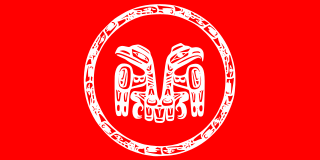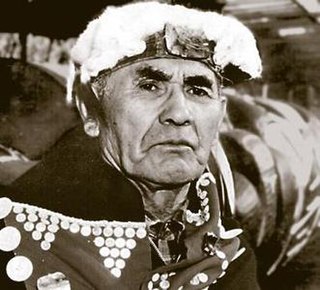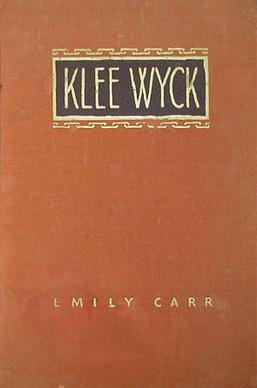Related Research Articles

William Ronald Reid Jr. was a Haida artist whose works include jewelry, sculpture, screen-printing, and paintings. Producing over one thousand original works during his fifty-year career, Reid is regarded as one of the most significant Northwest Coast artists of the late twentieth century.

Haida are an indigenous group who have traditionally occupied Haida Gwaii, an archipelago just off the coast of British Columbia, Canada, for at least 12,500 years.

Emily Carr was a Canadian artist and writer who was inspired by the Indigenous peoples of the Pacific Northwest Coast. One of the painters in Canada to adopt a Modernist and Post-Impressionist style, Carr did not receive widespread recognition for her 1929 work, The Indian Church, which is now her best known, until she changed her subject matter from Aboriginal themes to landscapes — forest scenes in particular, evoking primeval grandeur in British Columbia. As a writer Carr was one of the earliest chroniclers of life in her surroundings. The Canadian Encyclopedia describes her as a Canadian icon.

The Heiltsuk or Haíɫzaqv, sometimes historically referred to as Bella Bella, are an Indigenous people of the Central Coast region in British Columbia, centred on the island community of Bella Bella. The government of the Heiltsuk people is the Heiltsuk Nation, though the term is also used to describe the community. Its largest community is Bella Bella.
Robert Charles Davidson LL. D. D.F.A., is a Canadian artist of Haida heritage. Davidson's Haida name is G̲uud San Glans, which means "Eagle of the Dawn". He is a leading figure in the renaissance of Haida art and culture. He lives in White Rock, British Columbia.
Freda Diesing was a Haida woman of the Sadsugohilanes Clan, one of very few female carvers of Northwest Coast totem poles and a member of the Council of the Haida Nation of British Columbia, Canada. Her Haida name is Skil Kew Wat, meaning "magical little woman."

Florence Edenshaw Davidson (1896–1993) was a Canadian First Nations artist from Haida Gwaii. She created basketry and button-blankets and was a respected elder in her village of Masset, Haida Gwaii, British Columbia.
Reg Davidson is an Aboriginal Canadian carver and a member of the Haida band government.

Charles Edenshaw was a Haida artist from Haida Gwaii, British Columbia. He is known for his woodcarving, argillite carving, jewellery, and painting. His style was known for its originality and innovative narrative forms, created while adhering to the principles of formline art characteristic of Haida art. In 1902, the ethnographer and collector Charles F. Newcombe called Edenshaw “the best carver in wood and stone now living.”

Northwest Coast art is the term commonly applied to a style of art created primarily by artists from Tlingit, Haida, Heiltsuk, Nuxalk, Tsimshian, Kwakwaka'wakw, Nuu-chah-nulth and other First Nations and Native American tribes of the Northwest Coast of North America, from pre-European-contact times up to the present.

Chief Mungo Martin or Nakapenkem, Datsa, was an important figure in Northwest Coast style art, specifically that of the Kwakwaka'wakw Aboriginal people who live in the area of British Columbia and Vancouver Island. He was a major contributor to Kwakwaka'wakw art, especially in the realm of wood sculpture and painting. He was also known as a singer and songwriter.
Margaret B. Blackman is an anthropologist known for her work with the Haida First Nation of Haida Gwaii in British Columbia, Canada, beginning in the 1970s.

Joe David is a Nuu-chah-nulth artist, a member of the Tla-o-qui-aht Band of the Nuu-chah-nulth people, also formally "adopted" into the Haida people, whose work is identified with the contemporary Northwest Coast art movement; among his close associates are teacher and art historian Bill Holm, Duane Pasco, and his cousin Ron Hamilton. He is also a singer of traditional Nuu-chah-nulth songs, and has a strong interest in shamanic traditions, both those from his own culture and from others.
Farah Nosh is an Iraqi Canadian photojournalist. Her work about Iraq and its conflicts has been exhibited in galleries in the U.S. and UK.
Michael Nicoll Yahgulanaas is a visual artist, author, and public speaker. His work has been seen in public spaces, museums, galleries and private collections across globe. Institutional collections include the British Museum, Metropolitan Museum of Art, Seattle Art Museum, Vancouver Art Gallery, and the Humboldt Forum.

Nancy Jean Turner is a Canadian ethnobiologist, originally qualified in botany, who has done extensive research work with the indigenous peoples of British Columbia, the results of which she has documented in a number of books and numerous articles.

Klee Wyck (1941) is a memoir by Canadian artist Emily Carr. Through short sketches, the artist tells of her experiences among First Nations people and cultures on British Columbia's west coast. The book won the 1941 Governor General's Award and occupies an important place in Canadian literature.

Tanu is a traditional Haida village site located on Tanu Island, Haida Gwaii, opposite of Kung'a Island in Laskeek Bay, within the Gwaii Haanas National Park Reserve and Haida Heritage Site.
Kiusta located on Haida Gwaii is the oldest Northern Haida village: and the site of first recorded contact between the Haida and Europeans in 1774. Haida lived in this village for thousands of years, due to the sheltered nature of its location it was used for boats offloading, especially in rough waters. Kiusta is one of the oldest archeological sites of human use in British Columbia, and continues to be a site for cultural revitalisation.
References
- ↑ "Canadian Women Artists History Initiative : Artist Database : Artists : STELTZER, Ulli". cwahi.concordia.ca. Retrieved 2018-03-09.
- ↑ Ulli., Steltzer (1984). A Haida potlatch. Seattle: University of Washington Press. ISBN 0295961597. OCLC 10779534.
- 1 2 3 Cobb1 Morgan2, Myrna1 Sher2 (1978). Eight women photographers of British Columbia 1860-1978. Victoria, B.C. p. 64.
{{cite book}}: CS1 maint: location missing publisher (link) - ↑ "Ulli Steltzer - Graphic Arts". www.princeton.edu. Retrieved 2018-03-09.
- 1 2 3 4 Scott, Michael (2002). "Vancouver Photographer Ulli Steltzer has Traversed the Planet to Assemble Images of Privation and Nobility". Vancouver Sun.
- ↑ url=https://vancouversun.com/news/local-news/obituary-ulli-steltzer-photographer-with-a-social-conscience